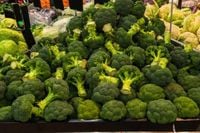As the United Kingdom endures its fourth sweltering heatwave of the summer, farmers across the country are grappling with one of the most challenging harvests in recent memory. On August 18, 2025, the effects of consecutive heatwaves and a persistent lack of rainfall have become impossible to ignore, especially for those growing broccoli and other vital crops. The result? Yields of broccoli have plummeted by more than 50%, and the quality and size of vegetables on supermarket shelves are already showing the strain.
According to the BBC, farmers in the driest regions are facing some of their worst ever harvests. The soils, bone-dry and unable to retain what little moisture is left, have left crops stunted and fields looking sparse. Ben Andrews, who runs a mixed organic farm near Leominster in Herefordshire, described the situation bluntly: shoppers will need to “shift their expectations” about what they find in stores. “You’ll be looking at maybe not quite as much availability and maybe needing to accept smaller heads of broccoli or lettuce or cabbage,” Andrews explained. “I’m not sure quite about shelves being empty, but if this continues it’s not completely impossible.”
Andrews’ warning isn’t just about broccoli. The British Growers Association (BGA) has confirmed that supplies of brassicas—including broccoli, cauliflower, and cabbage—are “tight.” Jack Ward, the BGA’s chief executive, told the BBC, “In some areas, supplies of summer brassicas, cauliflowers and cabbages are tight. Other root crops, carrots and onions have been kept going by the use of irrigation, but there are serious concerns about water supplies if the lack of rain continues.” Ward added, “At this stage, we are confident that the crops will be there, but the weather events of the last three months highlight the increasing uncertainty around our food supplies.”
This uncertainty is reflected in the numbers. Not only has broccoli production been slashed by more than half, but other key crops are also suffering. Farmers have reported significant shortfalls in cereals, potatoes, carrots, onions, and grass for animal feed. Martin Williams, an arable farmer and chairman of the National Farmers’ Union (NFU) Herefordshire branch, has seen a 50% drop in his cereal yield this season. “A third of the normal potato crop is likely, with a 70% drop in grass grown for feed,” Williams said. The conditions have been “absolutely, devastatingly dry,” he admitted, and the impact is forcing him to reconsider the viability of growing certain staple crops. “Going forward, it makes me wonder about the viability of growing cereal commodity crops. It is a risk-based job but if I can manage my risk down by not growing those risky crops then maybe that’s something I should look at.”
The Energy and Climate Intelligence Unit (ECIU), an independent think tank, has put these events into a broader perspective. The UK, they warn, is on course for its sixth or seventh worst harvest since records began 40 years ago. Tom Lancaster, ECIU’s head of land, food and farming, told the BBC, “I don’t think we should look at this year just in isolation. This is part of a pattern, coming off the back of the second worst harvest last year and the worst harvest on record in 2020. It’s that pattern we need to be concerned about because, as these impacts on agriculture and on farmers start to stack up, farmers will just effectively stop farming.”
The National Farmers’ Union (NFU) has echoed these concerns, describing the extremes of weather this year as “unprecedented.” Jamie Burrows, chairman of the NFU’s crops board, highlighted that while some areas with rainfall have seen “better-than-expected” yields, others are “facing significant drops which will have substantial financial implications on their businesses.” The overall harvest picture is, in Burrows’ words, “hugely varied.”
But what does this mean for the average shopper? The answer is twofold: expect to see smaller vegetables on the shelves, and prepare for higher prices at the checkout. As reported by The Independent, the adverse conditions have affected not just broccoli but a range of essential crops. The impact on crop yields is expected to be translated directly into price rises for vegetables, bread, and other food items. With supply tight, the cost of essentials is likely to climb, putting further pressure on households already feeling the pinch from broader economic challenges.
The root of the problem lies in the combination of low river levels, lack of rainfall, and the inability of lighter, drier soils to hold moisture. This has created a perfect storm for crops that require consistent hydration. While irrigation has helped keep some root crops like carrots and onions afloat, even these efforts are running up against serious concerns about dwindling water supplies. If the dry spell continues, the situation could become even more precarious, not just for this season but for the future of farming in some of the country’s most productive regions.
Some areas of the UK have been luckier. Farmers in cooler, wetter parts of the country are seeing better yields, and it is hoped that these regions will be able to compensate for the shortfalls elsewhere. The British Growers Association remains cautiously optimistic that, thanks to these pockets of better harvests, supermarkets will still be able to stock brassicas and other vegetables. But the warning signs are clear, and the situation remains fragile.
The impact of the heatwaves has not been confined to the UK. Across Europe, countries have experienced continent-wide heatwaves, with wildfires breaking out in several nations. The consequences have been severe, affecting public health, productivity, and water availability. In the UK, the ripple effects are being felt most acutely in the agricultural sector, where the ability to adapt and respond to extreme weather is being tested like never before.
Farmers and industry groups are calling for a reassessment of how food is produced and how risks are managed. The pattern of extreme weather—both wet and dry—over successive years is forcing a reckoning with the realities of climate change and its impact on food security. As Tom Lancaster from the ECIU put it, the cumulative impacts are stacking up, and without meaningful action, the future for many farmers looks increasingly uncertain.
For now, shoppers are being urged to adjust their expectations, both in terms of what they find on the shelves and what they pay at the till. The hope is that with better management, innovation, and perhaps a bit of luck from the weather, the UK’s farmers will continue to provide. But as this summer has shown, the margin for error is shrinking—and the stakes for the nation’s food supply have rarely been higher.




